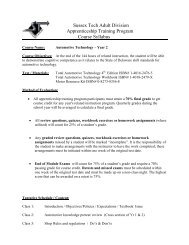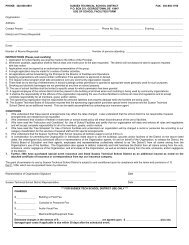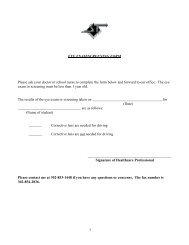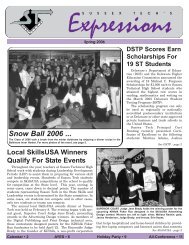11B: Stoichiometry
11B: Stoichiometry
11B: Stoichiometry
You also want an ePaper? Increase the reach of your titles
YUMPU automatically turns print PDFs into web optimized ePapers that Google loves.
Name:________________________________Section:_________Date:_______<br />
<strong>11B</strong>: <strong>Stoichiometry</strong>: Quantitative Precipitate<br />
Do the principles of stoichiometry really work? How do you use stoichiometry<br />
to determine the percentage yield of a reaction?<br />
This experiment will give us the opportunity to see<br />
if stoichiometry can actually predict the amount of<br />
products formed from a certain amount of<br />
reactants. By carrying out a precipitation reaction<br />
that forms solid copper(II) carbonate, we can<br />
measure the amount of product produced. This will<br />
be our “actual” yield. We can then compare the<br />
amount of product obtained to the calculated or<br />
“theoretical” yield based on stoichiometry. We will<br />
also use the data to determine the percentage yield<br />
of the solid product copper(II) carbonate.<br />
This lab uses a double replacement or precipitate reaction between copper(II) chloride (CuCl 2 ) and sodium<br />
carbonate (Na 2 CO 3 ). We will be able to predict the amount of product that should be formed according to<br />
the reaction:<br />
CuCl 2 (aq) + Na 2 CO 3 (aq) → CuCO 3 (s) + 2NaCl(aq)<br />
from the masses of reactants used. Before you begin, read through the entire procedure below so that you<br />
are familiar with each of the necessary steps.<br />
Part 1: Preparing the solutions<br />
CuCl 2 (s)<br />
Na 2 CO 3 (s)<br />
Filter paper<br />
Mass of CuCO 3 (s)<br />
and filter paper<br />
Mass of CuCO 3 (s)<br />
1. You will need two clean 250 mL beakers or Erlenmeyer flasks.<br />
2. Measure out approximately 1 g each of CuCl 2 and Na 2 CO 3 solids. The actual amount can be<br />
between 0.9 g and 1.1 g; it does not have to be exactly one. Record the exact amount that you<br />
measured in your data table.<br />
3. Place each solid in a beaker and add 25–30 mL of distilled water. Gently stir the mixture to<br />
dissolve the salts. Be sure to use a different stirring rod for each, so that you do not cross–<br />
contaminate your solutions.<br />
4. Record the color of each of your solutions.<br />
Materials<br />
• Two 250 mL Erlenmeyer flasks or beakers<br />
• Two stirring rods<br />
• One medium funnel<br />
• One piece of fast-flow filter paper<br />
• Distilled water bottle<br />
• Copper(II) chloride (CuCl2 )<br />
• Sodium carbonate (Na2CO3 )<br />
• Mass balance<br />
Table 1. Data table for Part 1<br />
Mass (g) Observations<br />
A NATURAL APPROACH TO CHEMISTRY 87
Investigation <strong>11B</strong>: <strong>Stoichiometry</strong>: Quantitative Precipitate<br />
Part 2: The precipitate reaction<br />
1. Slowly add a little CuCl 2 solution to the Na 2 CO 3 .<br />
Swirl to mix and record your observations.<br />
2. Slowly continue to add the CuCl2 to the Na2CO3 and<br />
swirl to mix. The slow addition of CuCl2 along with<br />
continuous swirling allows for the greatest amount of<br />
product to be formed, because more ions are able to<br />
contact each other.<br />
3. When all of the solution is added, rinse the empty<br />
flask with 3–5 mL of distilled water and add this to the<br />
mixture. This removes any remaining CuCl2 ions.<br />
Part 3: Isolating the product<br />
1. Obtain a piece of filter paper and fold it according to<br />
your instructor’s demonstration. (Fold it in half and<br />
then in half again.) Write your name in pencil near the<br />
top outside edge of the filter paper.<br />
2. Weigh the filter paper.<br />
3. Place the filter paper in the funnel, and place the<br />
funnel inside the neck of an empty Erlenmeyer flask.<br />
To make the funnel more secure, it helps to use a ring<br />
stand and place the funnel inside the ring with the<br />
flask below it.<br />
4. Wet the filter paper with a little distilled water so that three folds of paper are on one side and one<br />
paper thickness is on the other. This helps it stick to the funnel and keeps it in place.<br />
5. Swirl your mixture to suspend the solid in the solution. Slowly pour the mixture into the filter<br />
paper. As you pour the mixture, be sure that the solution does not come above the filter paper.<br />
Check to see that the “filtrate” (the solution draining into the flask below the funnel) is clear. If it<br />
is not clear, you may have a tear in your filter paper, or some mixture may have escaped over the<br />
top. You will need to refilter this to ensure that you capture all of your solid.<br />
6. Remove your filter paper containing the CuCO3 solid and place it in the area designated by your<br />
instructor, where it will dry overnight.<br />
7. Clean and rinse all equipment. You may need to use a test tube brush to remove solid particles<br />
stuck to the sides of glassware.<br />
8. During the next class period, weigh your filter paper and solid. Record the color and mass of the<br />
CuCO3 in your data table.<br />
88 A NATURAL APPROACH TO CHEMISTRY
Investigation <strong>11B</strong>: <strong>Stoichiometry</strong>: Quantitative Precipitate<br />
Part 4: Determining the percentage yield of your reaction<br />
1. Write out the balanced equation for this reaction.<br />
2. Complete the data table below.<br />
CuCl 2 (s)<br />
Na 2 CO 3 (s)<br />
CuCO 3 (s)<br />
(actual yield)<br />
Limiting reactant<br />
Theoretical yield<br />
of CuCO 3 (s)<br />
3. Calculate your percentage yield of CuCO 3 in this reaction.<br />
4. Was your percentage yield 100%? If not, give some reasons that you think may have caused this<br />
difference.<br />
5. List two sources of error that could have caused your actual yield to be low.<br />
6. List one source of error that could have caused your actual yield to be falsely high. Explain.<br />
Part 5: What did you learn?<br />
Table 2. Data table for Part 4<br />
Mass (g) Molar mass<br />
(g/mole)<br />
a. Describe what you learned about precipitate reactions from this investigation in a couple of<br />
sentences.<br />
b. Write a couple of sentences that explain how the actual yield and theoretical yield of CuCO 3 compare<br />
for your experiment.<br />
c. Compare your results with those of another group. How do your results compare?<br />
Moles<br />
d. What do you think was the largest source of error in obtaining a high percentage yield? Explain.<br />
e. In this experiment, what is the mole relationship between your reactants and the product CuCO 3 ?<br />
f. Did the limiting reactant need to be calculated in this investigation, given the fact that you used<br />
almost the same amounts of reactants? Briefly explain your answer.<br />
g. If you could do this experiment again, what would you do differently that might improve your<br />
percentage yield of CuCO 3 ?<br />
A NATURAL APPROACH TO CHEMISTRY 89
Investigation <strong>11B</strong>: <strong>Stoichiometry</strong>: Quantitative Precipitate<br />
Part 6: Practicing what you learned<br />
Suppose you carry out another similar experiment, this time with a different precipitate according to the<br />
following equation:<br />
In this experiment you obtain the following data:<br />
2NaOH(aq) + CuSO 4 (aq) → Cu(OH) 2 (s) + Na 2 SO 4 (aq)<br />
CuCl 2 (s) 1.0<br />
NaOH(s) 1.8<br />
Cu(OH) 2 (s)<br />
actual yield<br />
Limiting reactant<br />
Theoretical yield<br />
of Cu(OH) 2 (s)<br />
Table 3. Data table for Part 6<br />
Mass (g) Molar mass<br />
(g/mole)<br />
a. Calculate the molar mass of your reactants and solid product [Cu(OH) 2 ], and list them in the table<br />
above.<br />
b. Calculate the moles of your reactants and solid product [Cu(OH) 2 ], and list them in the table above.<br />
c. Determine which reactant was limiting. Support your answer with a calculation.<br />
d. Using your limiting reactant, determine how much solid Cu(OH) 2 you could have made if all of your<br />
reactants reacted and you were able to collect 100% of your solid product. What is this called?<br />
e. Determine the percentage yield for this reaction. Support your answer with a calculation.<br />
f. Give at least one source of error that could account for your result. Explain.<br />
Moles<br />
90 A NATURAL APPROACH TO CHEMISTRY










